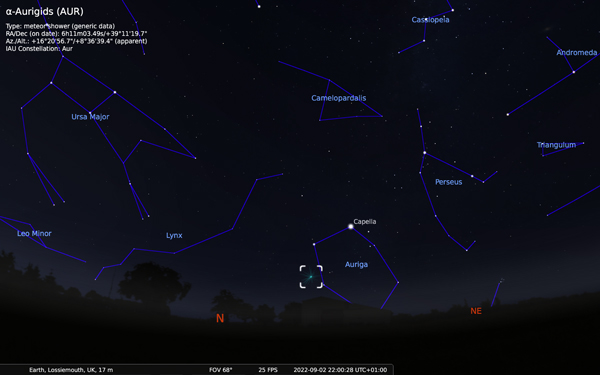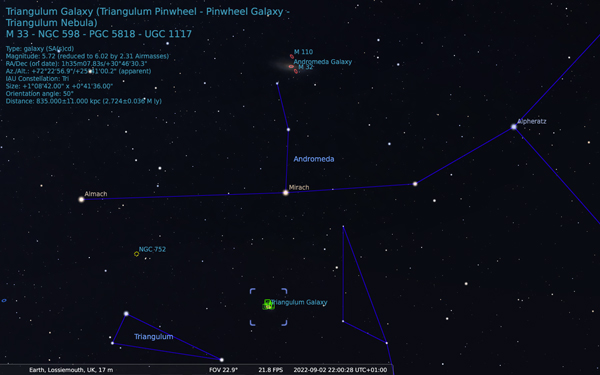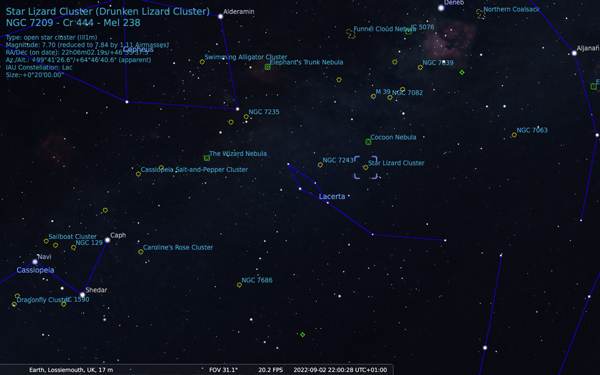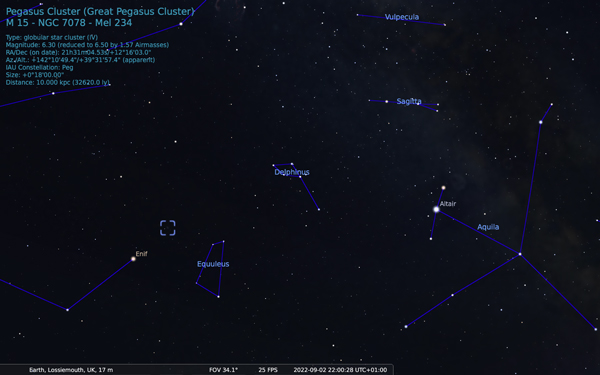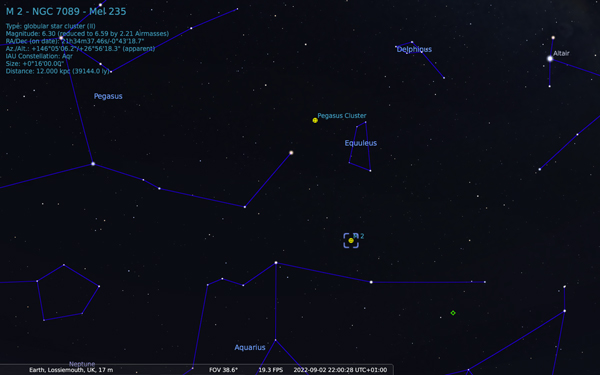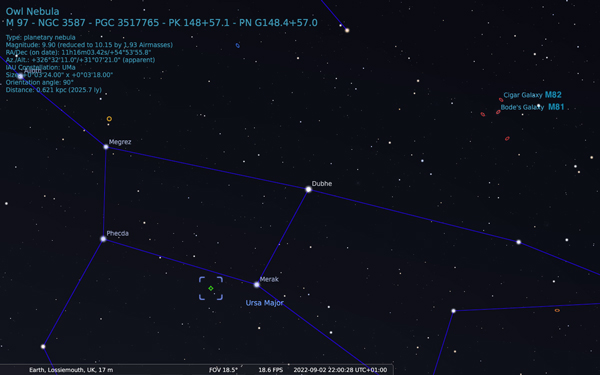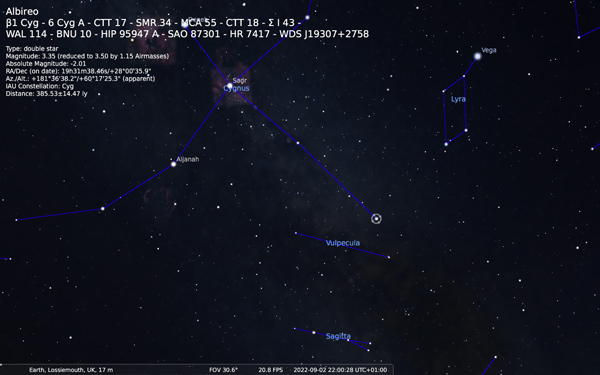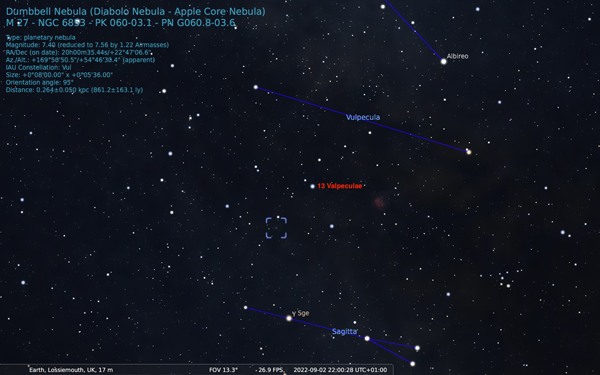Moray Sky at Night
September 2022

Moon Phases September 2022
First quarter: 3rd September
Full Moon: 10th September
Last quarter: 17thSeptember
New moon 25th September
Image courtesy of https://moonphases.co.uk
The Planets
Mercury
A difficult evening planet, and while reaching a greatest eastern elongation of 27° on 27th August it is desperately low. Opportunities for imaging are realistically during daytime, with great care needed. Inferior conjunction occurs on 23rd September.
Venus
Remains brilliant but low in the east-northeast before dawn, shrinking from 10.5 to 9.8 arcseconds as it heads for superior conjunction on 22nd October.
Mars
Early this month, the Red Planet moves east into Taurus, rather north of Aldebaran. It brightens to -0.5 Magnitude by the end of the month, achieving a good altitude at midnight. Southern summer (and hence northern winter) began on 21st July.
Jupiter
Reaches opposition on 26th September at a spectacular magnitude –2.9, in a subdued star field in Pisces. The gas giant also reaches an impressive equatorial diameter of 49.9 arcseconds, so much detail should be on offer. Transit phenomena of the Galileans are always interesting and on the night before opposition, Io transits mid-evening and occults its own shadow.
Saturn
Arrived at opposition well before Jupiter on 14th August, at magnitude –0.3. The ringed planet is slowly climbing the ecliptic, reaching eastern Capricornus and an altitude of 22°. Although only magnitude +0.3, in this rather barren part of the sky it should stand out well. On the days either side of opposition, the rings appear noticeably brighter (the Seeliger effect).
Uranus
The ice giant will be occulted by a waning gibbous Moon on the evening of 14th September. The tiny disc will appear from behind the dark limb, but its earlier disappearance beneath the brilliant limb will be difficult to observe.
Neptune
In eastern Aquarius, beats Jupiter to opposition by 10 days on 16th September.
MORAY’S NIGHT SKY – 15th September 2022 @22:00 hrs BST
Thanks to Chris Peat at Heavens-above.com for use of the star map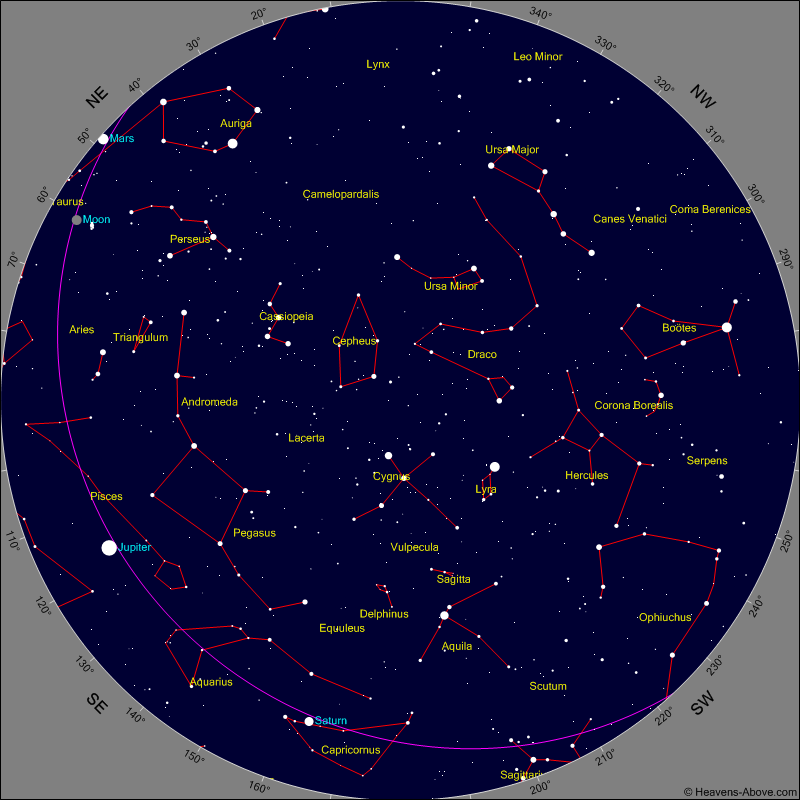
September Overview
At last, we have planets to observe at a reasonable hour for those averse to early rising. As the days shorten, a procession of favourite solar-system quarry becomes available – firstly Saturn, then Jupiter, with Mars becoming more prominent towards the equinox on 23rd September. During the warm late-summer nights, the Milky Way offers an array of treats for the deep-sky observer, so all tastes are catered for.
The Summer Triangle is now high in the southwest, made up of three first-magnitude stars: Vega in Lyra, Deneb in Cygnus, and Altair in Aquila.
Vega (alpha Lyrae) is a brilliant blue-white treasure. Lyra is a small but perfectly formed pattern that contains the famous Ring Nebula (Messier 57), the rather overlooked globular cluster Messier 56, and the ‘Double Double’, epsilon Lyrae (to the north of Vega). This is a wide pair of stars, within which each component is again a closer double and a good test for small telescopes. The wide pair is easily split using binoculars, as the two binaries are 208 arcseconds apart. Epsilon-1 (ε1) has stars of magnitude 4.7 and 6.2, separated by 2.6 arcseconds; epsilon-2 (ε2) has stars of magnitude 5.1 and 5.5, slightly closer at 2.3 arcseconds.
Rising high in the southeast this month is Pegasus with its unmistakable square shape that makes up the body of the flying horse. Pegasus and Andromeda are well clear of the horizon with M31 ideally situated for viewing. Some 15° below M31 lies M33, the Triangulum Galaxy.
Lower in the sky however, the appearance of the Pleiades is an indicator that autumn is almost upon us.
Above Andromeda is the small group of stars that forms Lacerta, the lizard. This constellation ranks 58th in order of size and contains few bright deep sky objects. There are however a number of open clusters, with NGC 7243 & NGC 7209 being the most obvious at magnitudes +6.4 & +6.7 respectively.
Looking southwards the most easterly of the three members of the Summer Triangle, Deneb, has reached the meridian. Directly south of Deneb are the small constellations of Delphinus, the dolphin and Equuleus, the small horse. Both of these belong to the original list of 48 constellations devised by Ptolemy in the second century AD. Whilst, with a little imagination, it might be possible to envisage the stars of Delphinus resembling a leaping dolphin.
Looking a little further south – but still on the meridian – brings us to Aquarius which contains the second object on Charles Messier’s list, M2. This is a fine globular cluster with a magnitude of +6.3.
To the north, the ‘nose’ of Ursa Major is just on the meridian immediately below the pole, with the popular pair of galaxies M81 & M82 still moderately well placed from the UK.
The main body of Auriga is now clearing the horizon along with the brilliant Capella, which will ride high in the sky in the depths of winter. Above the pole are Draco and Cepheus. The latter of these contains a variety of open clusters, the brightest being NGC 7160 at magnitude +6.1. It also accommodates the well-known Elephant’s Trunk Nebula within its boundaries.
September’s Object Challenge
This challenge this month is an easy one and one of Pete’s favourite Deep Sky Objects, M27 The Dumbbell Nebula. To find M27 find Albireo in Cygnus drop down to the constellation of Sagitta (The Arrow). Go to the star at the head of the arrow eta (h)Sagittae, in the constellation of Valpecula locate the star 13 Valpeculae which is not easy at mag 4.5. The Dumbbell Nebula is located approximately half in between these two stars.
ISS – September 2022
From 27th August until 9th September the ISS is a pre-dawn object. Then there are no visible passes of the ISS until the 16th September, when it will be an evening object until the 2nd October.
For more info go to https://www.heavens-above.com/PassSummary.aspx?satid=25544
For up to date timings and maps, if you make a fee account at Heavens Above and enter your location it gives you a precise timing and starmaps.
Clear Skies!
Mick

